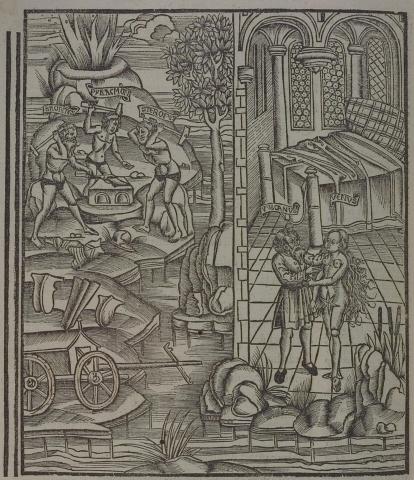Annotations
On the right, Venus approaches Vulcan in their bedroom, seducing him in order to convince him to make special armor for Aeneas to wear in battle (370-87). Vulcan does not appear to be resisting Venus's seductions, since he is facing toward her and has his hand on her shoulder. On the left is the forge of Vulcan under Mount Etna. Here, three Cyclopes, Brontes, Steropes, and Pyracmon, hammer out what appears to be a piece of armor. Brontes holds it in a pair of tongs, while he and the other two swing their hammers in rhythm to beat out the metal into shape (452-3). The workshop floor has various other metallic objects scattered on it. The chariot in the lower left must be the war chariot of Mars mentioned in lines 433-4: Parte aliā Martī currumque rotāsque volucrīs īnstābant, quibus ille virōs, quibus excitat urbēs.
Woodcut illustration from the “Strasbourg Vergil,” edited by Sebastian Brant: Publii Virgilii Maronis Opera cum quinque vulgatis commentariis expolitissimisque figuris atque imaginibus nuper per Sebastianum Brant superadditis (Strasbourg: Johannis Grieninger, 1502), fol. 319v, executed by an anonymous engraver under the direction of Brant.


Sebastian Brant (1458-1521) was a humanist scholar of many competencies. Trained in classics and law at the University of Basel, Brant later lectured in jurisprudence there and practiced law in his native city of Strasbourg. While his satirical poem Das Narrenschiff won him considerable standing as a writer, his role in the transmission of Virgil to the Renaissance was at least as important. In 1502 he and Strasbourg printer Johannes Grüninger produced a major edition of Virgil’s works, along with Donatus’ Life and the commentaries of Servius, Landino, and Calderini, with more than two hundred woodcut illustrations. (Annabel Patterson)